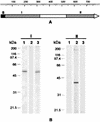Multigene families encoding the major hemagglutinins in phylogenetically distinct mycoplasmas
- PMID: 9632627
- PMCID: PMC108374
- DOI: 10.1128/IAI.66.7.3470-3475.1998
Multigene families encoding the major hemagglutinins in phylogenetically distinct mycoplasmas
Abstract
Mycoplasma synoviae has two major membrane antigens, MSPA and MSPB, both of which are phase variable and which may be coordinately involved in adhesion of the organism to erythrocytes. A single gene (vlhA) from M. synoviae was characterized, and polypeptides were expressed from nonoverlapping 5' and 3' regions in Escherichia coli. The expression product of the vlhA 5' region reacted with specific reagents against MSPB, while that of the 3' region reacted with specific reagents against MSPA. Analysis of the predicted amino acid sequence showed a characteristic signal peptidase II cleavage site, and the presence of the acylation site was confirmed by identification of a lipid-associated membrane protein, similar in molecular mass to MSPB, in [3H]palmitate-labelled membrane proteins. Further sequence analysis of the vlhA gene revealed a high identity with the Mycoplasma gallisepticum pMGA1.7 gene, a member of a large translated family. The vlhA gene was shown to hybridize to multiple restriction fragments of the M. synoviae genome, suggesting that it was also a member of a multigene family. These findings indicate that coordinate phase variation of the two major surface antigens of M. synoviae WVU may be due to their expression from the same gene and that homologous gene families encode the major hemagglutinins of two phylogenetically distinct mycoplasmas. The presence of homologous multigene families in such phylogenetically distinct species, but not in the genomes of more closely related species, suggests that the families may have been transferred horizontally.
Figures





References
-
- Baseggio N, Glew M D, Markham P F, Whithear K G, Browning G F. Size and genomic location of the pMGA multigene family of Mycoplasma gallisepticum. Microbiology. 1996;142:1429–1435. - PubMed
-
- Baseman J B, Reddy S P, Dallo S F. Interplay between mycoplasma surface proteins, airway cells, and the protean manifestations of mycoplasma-mediated human infections. Am J Respir Crit Care Med. 1996;154:S137–S144. - PubMed
-
- Bhugra B, Voelker L L, Zou N X, Yu H L, Dybvig K. Mechanism of antigenic variation in Mycoplasma pulmonis—interwoven, site-specific DNA inversions. Mol Microbiol. 1995;18:703–714. - PubMed
MeSH terms
Substances
Associated data
- Actions
LinkOut - more resources
Full Text Sources

